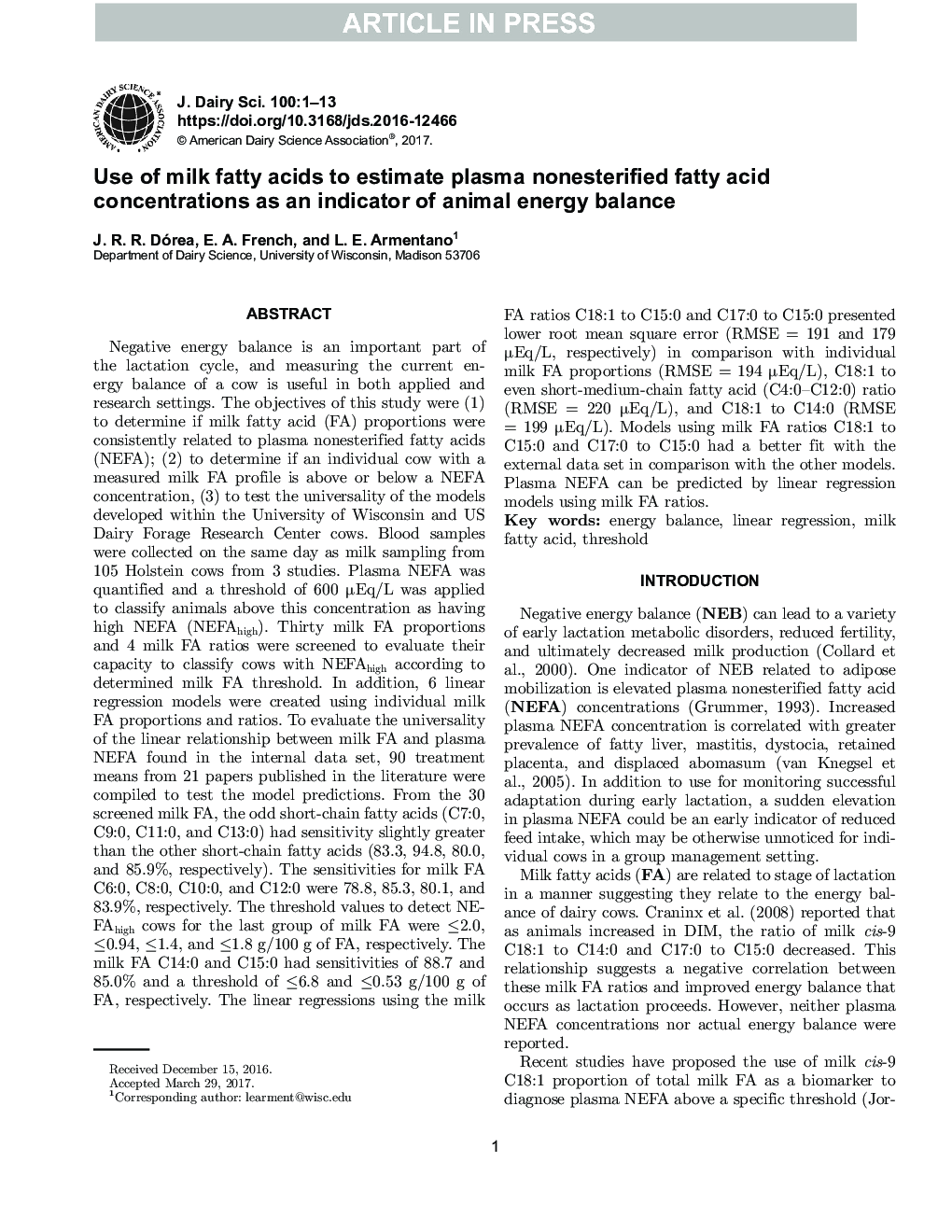| کد مقاله | کد نشریه | سال انتشار | مقاله انگلیسی | نسخه تمام متن |
|---|---|---|---|---|
| 5541899 | 1402512 | 2017 | 13 صفحه PDF | دانلود رایگان |
عنوان انگلیسی مقاله ISI
Use of milk fatty acids to estimate plasma nonesterified fatty acid concentrations as an indicator of animal energy balance
ترجمه فارسی عنوان
استفاده از اسیدهای چرب شیر برای برآورد غلظت اسید چرب غلیظ نشده پلاسما به عنوان شاخصی از تعادل انرژی حیوانات
دانلود مقاله + سفارش ترجمه
دانلود مقاله ISI انگلیسی
رایگان برای ایرانیان
کلمات کلیدی
تعادل انرژی، رگرسیون خطی، اسید چرب شیر آستانه،
موضوعات مرتبط
علوم زیستی و بیوفناوری
علوم کشاورزی و بیولوژیک
علوم دامی و جانورشناسی
چکیده انگلیسی
Negative energy balance is an important part of the lactation cycle, and measuring the current energy balance of a cow is useful in both applied and research settings. The objectives of this study were (1) to determine if milk fatty acid (FA) proportions were consistently related to plasma nonesterified fatty acids (NEFA); (2) to determine if an individual cow with a measured milk FA profile is above or below a NEFA concentration, (3) to test the universality of the models developed within the University of Wisconsin and US Dairy Forage Research Center cows. Blood samples were collected on the same day as milk sampling from 105 Holstein cows from 3 studies. Plasma NEFA was quantified and a threshold of 600 µEq/L was applied to classify animals above this concentration as having high NEFA (NEFAhigh). Thirty milk FA proportions and 4 milk FA ratios were screened to evaluate their capacity to classify cows with NEFAhigh according to determined milk FA threshold. In addition, 6 linear regression models were created using individual milk FA proportions and ratios. To evaluate the universality of the linear relationship between milk FA and plasma NEFA found in the internal data set, 90 treatment means from 21 papers published in the literature were compiled to test the model predictions. From the 30 screened milk FA, the odd short-chain fatty acids (C7:0, C9:0, C11:0, and C13:0) had sensitivity slightly greater than the other short-chain fatty acids (83.3, 94.8, 80.0, and 85.9%, respectively). The sensitivities for milk FA C6:0, C8:0, C10:0, and C12:0 were 78.8, 85.3, 80.1, and 83.9%, respectively. The threshold values to detect NEFAhigh cows for the last group of milk FA were â¤2.0, â¤0.94, â¤1.4, and â¤1.8 g/100 g of FA, respectively. The milk FA C14:0 and C15:0 had sensitivities of 88.7 and 85.0% and a threshold of â¤6.8 and â¤0.53 g/100 g of FA, respectively. The linear regressions using the milk FA ratios C18:1 to C15:0 and C17:0 to C15:0 presented lower root mean square error (RMSE = 191 and 179 µEq/L, respectively) in comparison with individual milk FA proportions (RMSE = 194 µEq/L), C18:1 to even short-medium-chain fatty acid (C4:0-C12:0) ratio (RMSE = 220 µEq/L), and C18:1 to C14:0 (RMSE = 199 µEq/L). Models using milk FA ratios C18:1 to C15:0 and C17:0 to C15:0 had a better fit with the external data set in comparison with the other models. Plasma NEFA can be predicted by linear regression models using milk FA ratios.
ناشر
Database: Elsevier - ScienceDirect (ساینس دایرکت)
Journal: Journal of Dairy Science - Volume 100, Issue 8, August 2017, Pages 6164-6176
Journal: Journal of Dairy Science - Volume 100, Issue 8, August 2017, Pages 6164-6176
نویسندگان
J.R.R. Dórea, E.A. French, L.E. Armentano,
